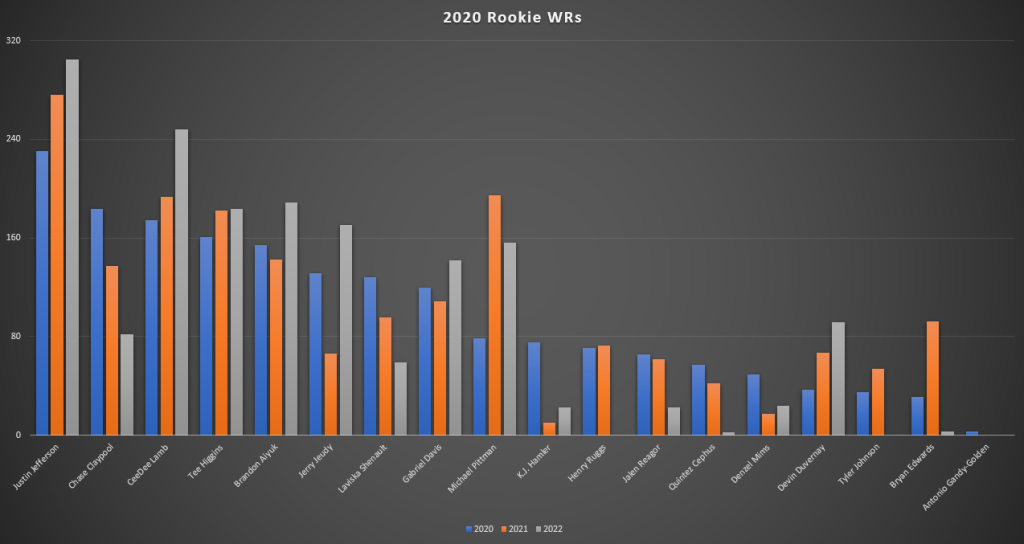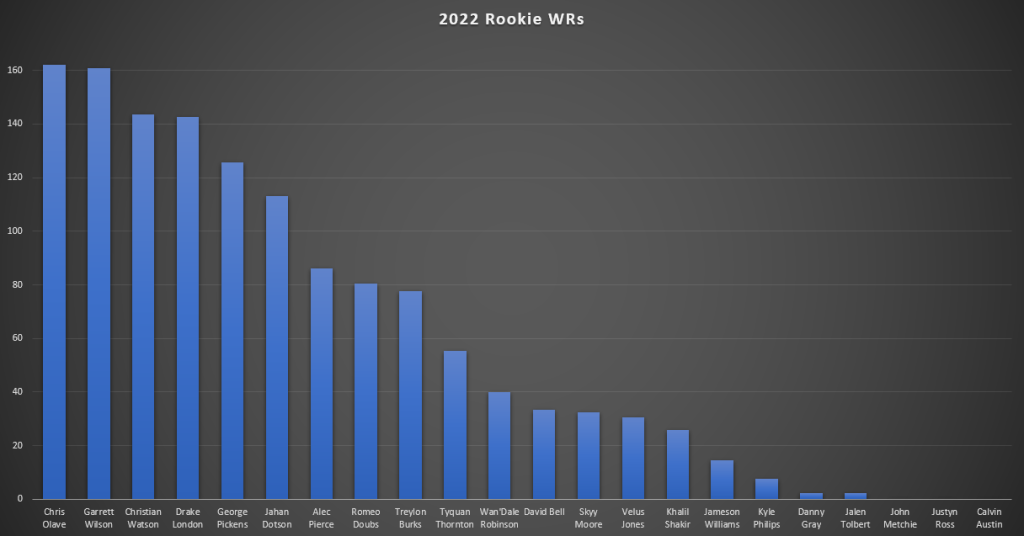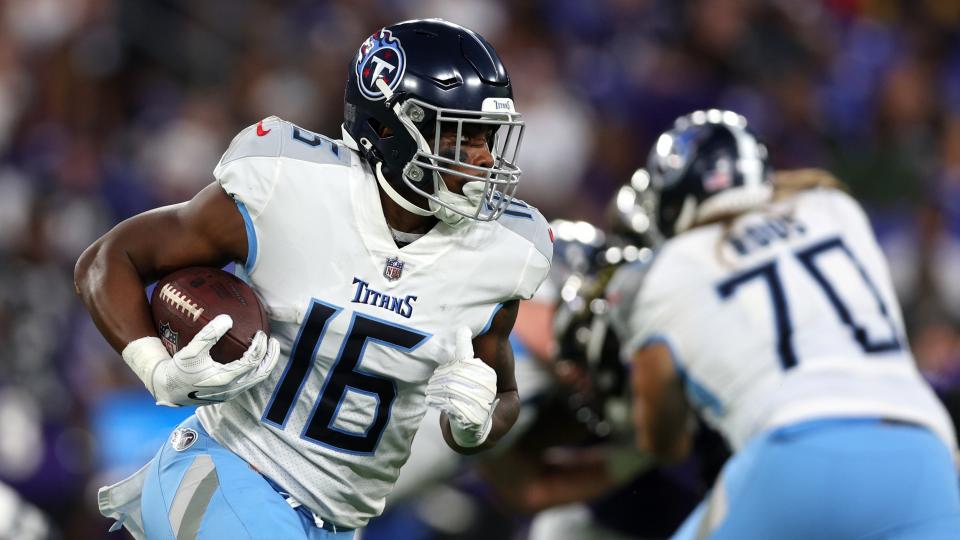Two off-seasons ago, I stared at my computer screen at a batch of wide receivers on my rosters and wondered if I should still believe in them. I had some rough seasons with a few squads and was trying to figure out the next step forward.
As I sat and stared, I wondered if there would be a way to help understand the probability of success for players based on actual NFL data. Many of our writers on Dynasty Nerds are devy experts, college football junkies, and amazing at scouting talent. I also felt like I had an eye for finding some guys coming into the pros. But I wanted stats incorporating actual pro success while still being related to younger and more valuable assets.
So, I did the only thing I thought I could do to understand this better: I started to chart as much data as I could. I looked for tendencies, probabilities, and signs of success or failure in the early careers of players. And after a while, something stuck out: Rookie WR success/failure has a high probability of foreshadowing a player’s whole career.
Now in the third off-season of charting this, let’s look into the tendencies and probabilities of pro success based strictly off of a wide receiver’s rookie season. If you are the owner of at least one receiver who just finished their rookie campaign, you may want to see what the past is telling us about your receiver’s future.
History
In that 2021 off-season, I charted wide receivers back to the 2015 rookie class. At the time, this gave me five full classes of receivers that had played at least two seasons. Looking through these receiver years and totals, I wanted to see if I could understand what the chances are of the 2020 class of WRs having successful careers.
I looked at the total points scored by wide receivers every year of their career. I didn’t want to make exceptions for injuries, suspensions, illness, or any other factors that could impact their season total. Very simply, what did they score each season in fantasy football?
Using these totals, I created a threshold that looked like an acceptable number of points scored for a receiver in their rookie season. Until last season, that total was 80 points or five points per game. This threshold is now 85 points as every NFL team plays one more regular season game. This is all in 0.5 PPR format.
For your viewing pleasure, here is a scatter plot of all seasons for rookie WRs from 2015 to 2019:

The only thing to pay attention to is the vertical axis on this chart. The higher up the vertical axis, the better the season. And take a look at the names that fall below the 80-point threshold.
You will likely notice one name very quickly, just below 80 points in his rookie year, which is one of the exceptions I have found in this process: Chris Godwin. I have mentioned Godwin every year I have done this process, including in last year’s recap.
From 2015 to 2019, 46 wide receivers did not make the threshold their rookie season. Since then, only four of those WRs averaged 100 points or more in the seasons after their rookie campaign: Godwin, Chargers WR Mike Williams, Panthers/Commanders WR Curtis Samuel, and Titans/Jets WR Corey Davis.
Samuel and Davis have averaged over 100 points per season since their rookie year. But neither has ever been an amazing option in fantasy. The best Davis ever finished in 0.5 PPR is WR28. Samuel’s best was WR25. Neither has ever finished as even a WR2 in 12-team leagues.
Regarding Godwin and Williams, Godwin was the second-best WR in 2019 and finished WR17 in 2021 and WR19 this past season. Williams was WR10 in 2021 and WR24 in 2018. Five out of a combined ten seasons, they finished as a top-24 wideout.
2020 and 2021
With all that background, we can discuss the last two seasons prior to the 2022 class of rookies. These two classes are where all of my charting began. Did the trends of 2015-2019 continue in the 2020s?
The first season I charted was 2020, and the list of rookies I was warning readers about had some people upset with me—specifically, Jalen Reagor and Bryan Edwards owners. I was told that Reagor had some injuries and bad QB play. I was told Edwards hadn’t quite learned the offense yet. Both camps told me I was giving up far too early on both players.
Two years later, it is easy to stand by my initial assessment.
However, I also warned that owning Michael Pittman was shaky. He had finished just below the threshold and was a candidate for selling. In last year’s article, I talked about Pittman as a new exception, like Godwin and Williams before him.
I still hold to that; Pittman is an asset you aren’t upset owning in fantasy. But he did finish as WR26 this past season. The 2021 season as WR15 is the only season he was a big-time asset for your fantasy teams thus far in his career. We will have to see how he performs in 2023.
Here is a look at all the 2020 rookie WRs and their totals in their first three seasons:

As for 2021, the line in the threshold is a bit cleaner once again. Of the 17 rookie wide receivers drafted in the first four rounds in rookie ADP, 12 of them did not make the threshold (which is 85 points now). The most considerable push-back I had in this class was Rashod Bateman. Owners were upset when I said he might be worth selling after his rookie season.
Yes, Bateman’s 2022 was cut short due to injury. But he has yet to become a viable asset for owners in fantasy. And if your argument back is that he was not healthy this year (while this article and process has nothing to do with PPG), I would point out that Bateman was still WR55 in PPG on the year.
Here is a look at the first two seasons in the NFL for the 2021 rookie WR class:

Joshua Palmer is the one exception to the chart currently for receivers that didn’t hit the threshold their rookie year. But even his improved second year only brought him in as WR38 on the season. I wouldn’t count him as an exception quite yet.
The Opposite View
This feels like a good time to mention that this process is not as conclusive the other way around. There have been many rookie WRs clearing the threshold and having lackluster careers later. You may have noticed this on the last two charts, with Elijah Moore, Chase Claypool, and Laviska Shenault having cleared the rookie threshold and all taking dips since then.
There are many examples from 2015 to 2019 as well. Dorial Green-Beckham, Tajae Sharpe, Malcolm Mitchell, Dante Pettis, Antonio Callaway, and Tre’Quan Smith are all receivers who hit the rookie threshold and ended up never having a fantasy season over 100 points the rest of their career.
All of this is to say that this process is not guaranteeing your rookies that have shown success will always have success. The probability is still high that they will continue this trend, but nowhere near the probability that a rookie missing the threshold will continue to struggle.
Adding in the 2020 and 2021 receivers to the totals from the 2015 to 2019 classes, there were 68 receivers taken in the first four rounds of rookie drafts that did not hit the rookie threshold. Of these 68, I would only consider Godwin, Williams, and Pittman exceptions to this process. That means 95% of the receivers that missed the rookie threshold continued on a mediocre to bad fantasy career.
On the other side, 12 of the 47 receivers that hit the threshold have not gone on to have even a WR3 season after their rookie year. This would be a 74.5% hit rate of having at least one more relevant fantasy season after hitting the rookie threshold.
This is to say that the process here is better for identifying players to trade away, not players to acquire per se.
2022
“Get to the point, Tim!” I can hear you all yelling it now. Let’s get to this year’s class.
Here are the totals for the 2022 rookie wide receivers:

If you paid attention to fantasy this year, it should be no surprise that Chris Olave, Garrett Wilson, Christian Watson, Drake London, and George Pickens made the cut. Jahan Dotson also made the threshold in only 12 games played. And the final member of the above-the-threshold club was Alec Pierce, squeaking in at 86.1 points.
The names that stand out to me that finished below the threshold are Treylon Burks, Skyy Moore, and Romeo Doubs. Burks and Moore were both first-round ADP receivers in 2022 rookie drafts, and Doubs was hyped up during Packers camp and leading into the 2022 season.
Many of you will note that Burks only played in 11 games. Doubs missed four games as well. But remember, this process does not account for how they finish their rookie season. Injuries are unimportant in this process.
All of this is up to each owner to decide how to go forward. I am not saying Burks is destined for failure. I am not saying Moore can never have a good season. One name I didn’t mention, Jameson Williams, essentially missed his entire rookie year. Does missing the threshold doom him as well?
Again, this is for every owner to decide on their own. All I can point to is the stats. And they are overwhelming. Only 4.4% of receivers that have missed this threshold have gone on to be exceptions to the rule. Do you believe you have the next guy? Or should you sell while there is something you can still get in return?
Why does any of this matter?
You may ask yourself why anyone would take such a short sample size and apply it to major decisions with their fantasy team. Can you give up on a guy because of one mediocre or lousy year at the start of their career?
In short: yes. You can judge them this quickly. The numbers don’t lie. The odds are stacked against you that your player will gain more value than they currently have after a mediocre rookie season. And value is everything in fantasy football.
Let’s take the two players that started this entire process for me back in February 2021: Jalen Reagor and Bryan Edwards.
ADP in May 2020 (right after both were drafted in the 2020 NFL draft):
- Reagor: WR25, 50.83 overall
- Edwards: WR52, 98.17 overall
ADP in May 2021 (three months after I advised you to sell Reagor and Edwards):
- Reagor: WR46, 95.83 overall
- Edwards WR65, 143.17 overall
ADP in May 2022 (after two full seasons in the NFL):
- Reagor: over WR117, over 271 overall (my ADP chart only goes this high, and Reagor wasn’t on it)
- Edwards: WR93, 215.33 overall
A player’s career is not over because of a bad rookie season. And neither is their value. We recognize if a wide receiver has a slow start to their career. Their value has a dip. But we still have an interest.
If they have two bad seasons, this is a trend now—their value plummets. Our interest is near gone.
You can still salvage value now and recoup some of your investment. You can look at a player like Treylon Burks right now, whether you own him or not, and say, “I think he can still be good.” But what happens if his 2023 campaign is mediocre? Do you believe in him, then? If you own him, do you think you can sell him?
Keep this in mind as you evaluate those rookie wide receivers. There is no shame in selling someone a year early. But there is sadness in selling them too late. How much do you trust your players to be the exception to the rule?
Get ready for your rookie draft with the DynastyGM!! Rankings, trade calculator, league analyzer, and much more. Just $4.99/month, or better yet, bundle with the Nerd Herd for just $6.99/month and get extra podcasts, the Dynasty Prospect Film Room, and more.


















